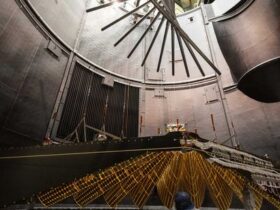NASA’s Hubble Space Telescope is known for its incredible space shots, and the last one is no exception! Recently, Hubble returned to the Veil Nebula to capture it like never before.
The new image highlights the nebula’s intriguing features in some of the most striking shades thanks to a new processing technique Hubble applied.Â
Check out below some of the Veil Nebula’s finest details, including some filament of ionized gas and delicate threads.
Here is what you need to know.
The Veil Nebula’s Striking Features Captured by Hubble
The Veil Nebula is approximately 2,100 light-years away from us, in a constellation named Cygnus, aka the Swan. Being so close to Earth, astronomers could have explored the nebula several times using different techniques.
Hubble snapshot details
To capture such a striking image, observations were realized by Hubble’s Wide Field Camera 3 device using five filters.
The novel post-processing techniques have also improved never-seen-before details of emissions from ionized nitrogen (with red), ionized hydrogen, and ionized oxygen (with blue hues).
You can see the Veil Nebula below:

The birth of a nebula
The Veil Nebula is the noticeable part of the nearby Cygnus Loop, which is nothing but a supernova remnant. It resurfaced around 10,000 years ago by the death of a massive star.
According to astronomers’ calculations, that star was actually 20 times the Sun’s mass, and it lived extremely fast and died very young.Â
Once with its death, the star released a vast deal of energy. Later on, the debris and shockwaves from the supernova shaped the Veil Nebula we can see today. The nebula got some of the most incredible traceries of ionized gas, displaying an intriguing scenery of astronomical features.Â
In Hubble’s Caldwell Catalog, you can find the Veil Nebula alongside other fantastic cosmic objects captured by the Hubble Space Telescope over the years.













Leave a Reply